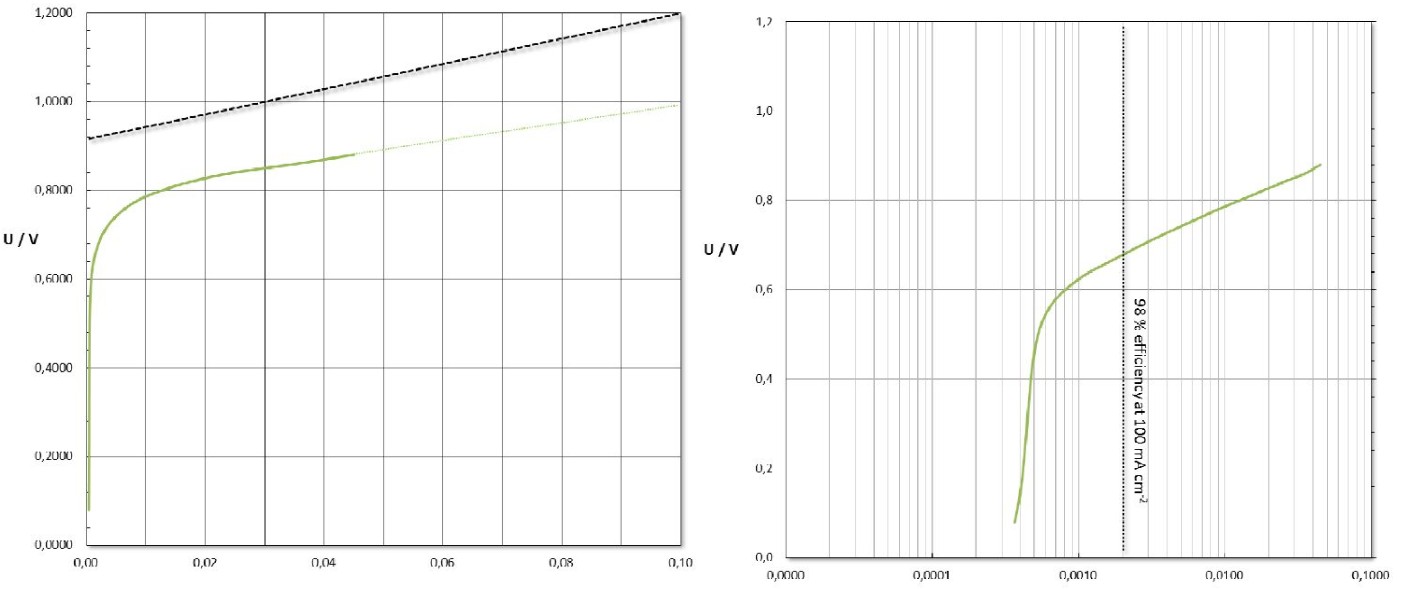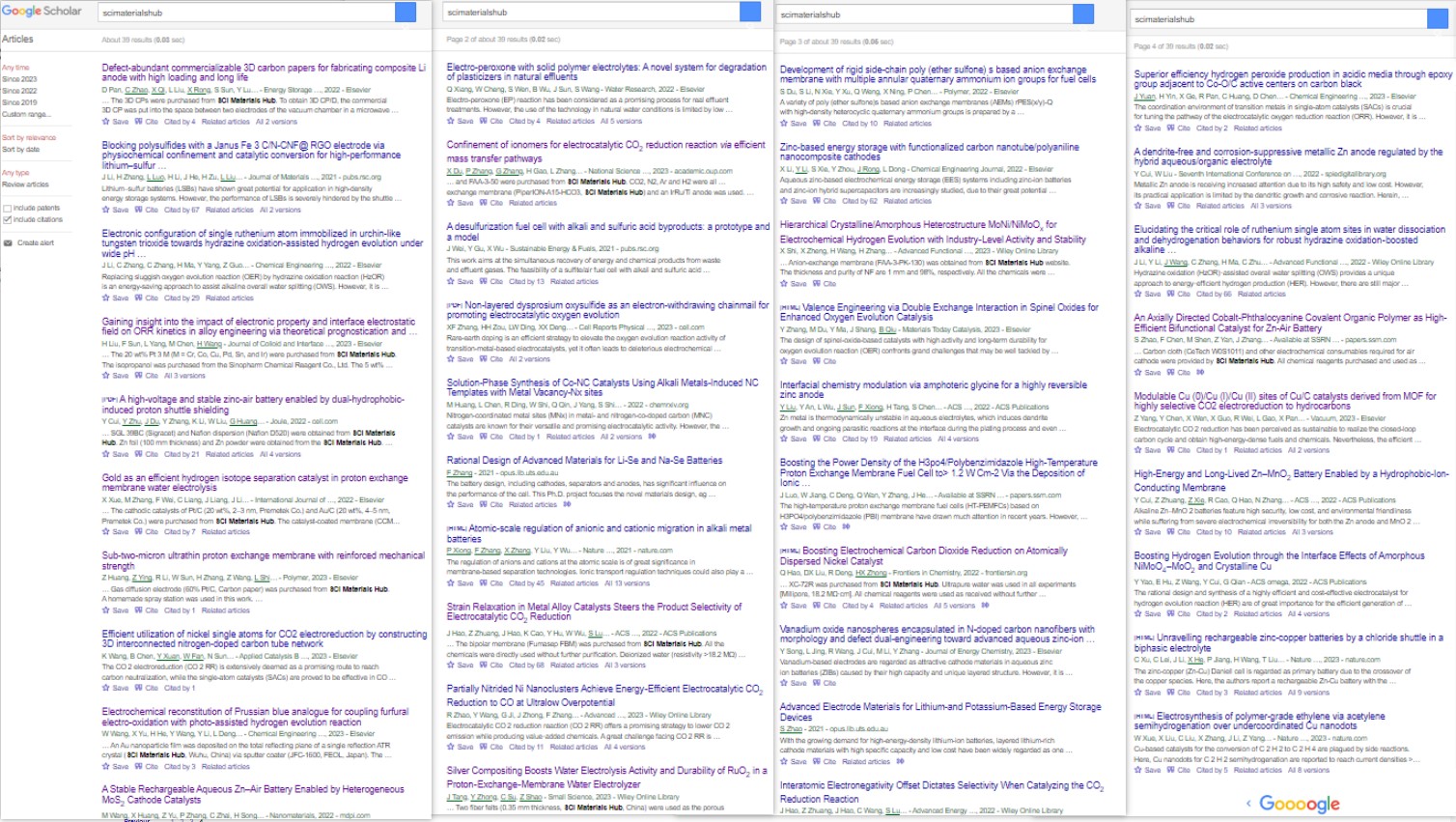
1. Introduction
Fumasep FBM Bipolar Exchange Membrane with PK reinforcement consists of an anion exchange layer and a cation exchange layer manufactured using a patented multilayer-coating production technology. The polymer backbone for this bipolar membrane is based on hydrocarbon polymer materials.
This composite membrane is chemically stable and mechanically reinforced with woven PEEK. In the intermediate layer between Anion Exchange Layer (AEL) and Cation Exchange Layer (CEL), water is dissociated into OH- and H+ ions when exceeding a potential difference of approximately 0.8 V. The CEL must be directed towards the cathode, the AEL must be directed towards the anode, and the mode of operation has to be reverse biased in order to promote the water dissociation reaction. Under the reverse biased mode, the electrons would be transferred from anode side to cathode side. Water molecules would naturally diffuse into the intermediate layer between AEL and CEL and generation of H+ and OH- ions would occur as a result of water splitting reaction. H+ ions will diffuse out from the CEL layer and migrate into the cathode chamber. OH- ions, on the other hand, would diffuse out from the AEL layer and migrate into the anode chamber.
2. Delivery
The membrane is the brown foil delivered in wet form.
The standard size of this membrane is 20*30cm. Customized dimensions can be made upon request.
3. Precautions
The Fumasep FBM membrane should not be operated under forward bias conditions which may cause blistering at the water dissociation layer. Under forward biasing conditions, water generation reaction will take place at the intermediate layer instead of water splitting reaction. H+ ions will diffuse into the CEL and OH- will diffuse into the AEL during forward biased operational mode and combination of these two ions at the intermediate layer will create water and hence, accumulation of water will happen over time. Depending on the duration of the forward biasing mode and current density or voltage, the water that accumulates at the center would eventually damage the bipolar membrane irreversibly. If the membrane is used in the wrong position at high current density even for short term (specifically referring to forward bias scenario), the interim layer may degrade (blistering or ballooning), and the monolayers may delaminate. Depending on the operational parameters of the forward biasing, micro-tears or micro-cracks that are invisible to the naked eye may form and initiate the cross-contamination of the electrolytes located in different compartments.
The electro-catalytically forced water dissociation produces – in contrast to the classical electrolysis of water – no reaction gases. Therefore, one Mol of OH- and H+ – ions can be achieved at an energy value of approximately 22 Wh (Electrolysis: approximately 55 Wh per Mol).
Fumatech membranes are highly sensitive to differences in humidity and moisture content. Therefore the membranes can vary +/- 0.5cm from the original cut sizes. Also due to this sensitivity the manufacturer expects wrinkles to form, however soaking the membranes in deionized water will return the membranes to the full size planar state according to the manufacturer.
4. Features
- Application: Salt Splitting
- Bipolar Exchange Membrane
- Stability range (pH) at 25 °C: 1 - 14
- Can withstand high caustic concentrations
- Thickness: 200 - 250 micrometers (μm)
Fumasep FBM membrane is Easy to Use and Show
- High water splitting efficiency (> 98% at 100 mA cm-2 in 0.5 M NaCl at 25°C)
- Low water splitting voltage (< 1.2 V at 100 mA cm-2 in 0.5 M NaCl at 25°C)
- Excellent mechanical properties at low thickness (0.13 – 0.16 mm)
5. Welcome to cite our materials in your papers
Fumasep FBM-PK, a bipolar exchange membrane with PK reinforcement, was obtained from SCI Materials Hub.
Download:
![]() fumasep FBM-PK (wet form) Technical Data Sheet.pdf
fumasep FBM-PK (wet form) Technical Data Sheet.pdf
| Membrane Properties | |
| Membrane | Bipolar |
| Thickness | 130 - 160 μm (microns) |
| Appearance / Color | Transparent / Brown |
| Backing Foil | None |
| Delivery Form | Wet in NaCl solution |
| Reinforcement | PK |
| Density | 15 - 17 mg*cm-2 |
| Counter Ion | Na (CEM layer ) / Cl (AEM layer) |
| Max Temperature | 40 °C |
| Dimensional Swelling in H2O at 25°C | 0 % |
| Water Splitting Voltage at 100mA cm-2 | < 1.2 V |
| Water Splitting Efficiency at 100mA cm-2 | > 98 % |
Please pay attention that the membrane surface is not contaminated with surface active agents or will be damaged by mechanical influence.
High attention must be given to the right polarity when using the membranes!
When mounting the membranes it is imperative that the membrane sides will not get mixed up. Therefore, the cation side is marked with ‘Cathode Side’. This side must be directed towards the cathode (see also drawing overleaf).
The membrane should be stored in 1 M NaCl-solution and placed in a closed container. If storage will be for a longer period of time 100 ppm of NaN3 should be added to prevent biological growth. Other biocides have not been used as yet.
The membrane is not stable against chlorine (Cl2).
If you have any concerns before proceeding, please feel free to contact us for further information.
- 4-chamber set-up: cathode – Na2SO4 – CEM – NaCl – FBM – NaCl – CEM – Na2SO4 solution – anode
- 4-probe measurement: Haber-Luggin capillary (3 M KCl) with Ag / AgCl reference electrodes
- CEM: Cation exchange membrane FKB
- Electrolyte loop: 0.5 M NaCl solution / recombined
- Electrode loop: 0.25 M Na2SO4 / recombined
- Temperature: 25°C
- Fixed scan rate, ΔU = 20 mV, Δt = 20 s

For international orders, please ask us for quotes via
Email: contact@scimaterials.cn
Tel: +86 153-5789-9751
Wechat: SCI-Materials-Hub
Clik here to put quick orders on our Alibaba shop
Fumasep FBM-PK Bipolar Membrane | |
Product Code | 15330100 |
| Description | Fumasep FBM-PK Bipolar Membrane |
| Retail Price (USD$) | $99 (10CM*10CM,Item#:15330100-1010) $349 (20CM*20CM,Item#:15330100-2020) $449 (20CM*30CM,Item#:15330100-2030) |
Lead Time & Availability | 1 day & In Stock |
SCI Materials Hub Is Committed to Offering The Best Price & Customer Services! | |
Worldwide shipping via DHL, SF-Express & other requested carriers.
Payments via Bank Transfer, Paypal, Credit card (via Taobao), Alipay, Wechat-pay are accepted.
Partial references citing our materials (from Google Scholar)

Carbon Dioxide Reduction
1. ACS Nano Strain Relaxation in Metal Alloy Catalysts Steers the Product Selectivity of Electrocatalytic CO2 Reduction
The bipolar membrane (Fumasep FBM) in this paper was purchased from SCI Materials Hub, which was used in rechargeable Zn-CO2 battery tests. The authors reported a strain relaxation strategy to determine lattice strains in bimetal MNi alloys (M = Pd, Ag, and Au) and realized an outstanding CO2-to-CO Faradaic efficiency of 96.6% with outstanding activity and durability toward a Zn-CO2 battery.
2. Front. Chem. Boosting Electrochemical Carbon Dioxide Reduction on Atomically Dispersed Nickel Catalyst
In this paper, Vulcan XC-72R was purchased from SCI Materials Hub. Vulcan XC 72R carbon is the most common catalyst support used in the anode and cathode electrodes of Polymer Electrolyte Membrane Fuel Cells (PEMFC), Direct Methanol Fuel Cells (DMFC), Alkaline Fuel Cells (AFC), Microbial Fuel Cells (MFC), Phosphoric Acid Fuel Cells (PAFC), and many more!
3. Adv. Mater. Partially Nitrided Ni Nanoclusters Achieve Energy-Efficient Electrocatalytic CO2 Reduction to CO at Ultralow Overpotential
An AEM membrane (Sustainion X37-50 Grade RT, purchased from SCI Materials Hub) was activated in 1 M KOH for 24 h, washed with ultra-purity water prior to use.
4. Adv. Funct. Mater. Nanoconfined Molecular Catalysts in Integrated Gas Diffusion Electrodes for High-Current-Density CO2 Electroreduction
In this paper (Supporting Information), an anion exchanged membrane (Fumasep FAB-PK-130 obtained from SCI Materials Hub (www.scimaterials.cn)) was used to separate the catholyte and anolyte chambers.
SCI Materials Hub: we also recommend our Fumasep FAB-PK-75 for the use in a flow cell.
5. Appl. Catal. B Efficient utilization of nickel single atoms for CO2 electroreduction by constructing 3D interconnected nitrogen-doped carbon tube network
In this paper, the Nafion 117 membrane was obtained from SCI Materials Hub.
In this paper, Proton exchange membrane (Nafion 117), Nafion D520, and Toray 060 carbon paper were purchased from SCI Materials Hub.
7. National Science Review Confinement of ionomer for electrocatalytic CO2 reduction reaction via efficient mass transfer pathways
An anion exchange membrane (PiperION-A15-HCO3) was obtained from SCI Materials Hub.
8. Catalysis Communications Facilitating CO2 electroreduction to C2H4 through facile regulating {100} & {111} grain boundary of Cu2O
Carbon paper (TGPH060), membrane solution (Nafion D520), and ionic membrane (Nafion N117) were obtained from Wuhu Eryi Material Technology Co., Ltd (a company under SCI Materials Hub).
Batteries
1. J. Mater. Chem. A Blocking polysulfides with a Janus Fe3C/N-CNF@RGO electrode via physiochemical confinement and catalytic conversion for high-performance lithium–sulfur batteries
Graphene oxide (GO) in this paper was obtained from SCI Materials Hub. The authors introduced a Janus Fe3C/N-CNF@RGO electrode consisting of 1D Fe3C decorated N-doped carbon nanofibers (Fe3C/N-CNFs) side and 2D reduced graphene oxide (RGO) side as the free-standing carrier of Li2S6 catholyte to improve the overall electrochemical performance of Li-S batteries.
This paper used more than 10 kinds of materials from SCI Materials Hub and the authors gave detailed properity comparsion.
The commercial IEMs of Fumasep FAB-PK-130 and Nafion N117 were obtained from SCI Materials Hub.
Gas diffusion layers of GDL340 (CeTech) and SGL39BC (Sigracet) and Nafion dispersion (Nafion D520) were obtained from SCI Materials Hub.
Zn foil (100 mm thickness) and Zn powder were obtained from the SCI Materials Hub.
Commercial 20% Pt/C, 40% Pt/C and IrO2 catalysts were also obtained from SCI Materials Hub.
3. Journal of Energy Chemistry Vanadium oxide nanospheres encapsulated in N-doped carbon nanofibers with morphology and defect dual-engineering toward advanced aqueous zinc-ion batteries
In this paper, carbon cloth (W0S1011) was obtained from SCI Materials Hub. The flexible carbon cloth matrix guaranteed the stabilization of the electrode and improved the conductivity of the cathode.
4. Energy Storage Materials Defect-abundant commercializable 3D carbon papers for fabricating composite Li anode with high loading and long life
The 3D carbon paper (TGPH060 raw paper) were purchased from SCI Materials Hub.
5. Nanomaterials A Stable Rechargeable Aqueous Zn–Air Battery Enabled by Heterogeneous MoS2 Cathode Catalysts
Nafion D520 (5 wt%), and carbon paper (GDL340) were received from SCI-Materials-Hub.
Carbon cloth (W0S1011) and other electrochemical consumables required for air cathode were provided by SCI Materials Hub.
Oxygen Reduction Reaction
1. J. Chem. Eng. Superior Efficiency Hydrogen Peroxide Production in Acidic Media through Epoxy Group Adjacent to Co-O/C Active Centers on Carbon Black
In this paper, Vulcan XC 72 carbon black, ion membrane (Nafion N115, 127 μL), Nafion solution (D520, 5 wt%), and carbon paper (AvCarb GDS 2230 and Spectracarb 2050A-1050) were purchased from SCI Materials Hub.
2. Journal of Colloid and Interface Science Gaining insight into the impact of electronic property and interface electrostatic field on ORR kinetics in alloy engineering via theoretical prognostication and experimental validation
The 20 wt% Pt3M (M = Cr, Co, Cu, Pd, Sn, and Ir) were purchased from SCI Materials Hub. This work places emphasis on the kinetics of the ORR concerning Pt3M (M = Cr, Co, Cu, Pd, Sn, and Ir) catalysts, and integrates theoretical prognostication and experimental validation to illuminate the fundamental principles of alloy engineering.
Water Electrolysis
1. International Journal of Hydrogen Energy Gold as an efficient hydrogen isotope separation catalyst in proton exchange membrane water electrolysis
The cathodic catalysts of Pt/C (20 wt%, 2–3 nm) and Au/C (20 wt%, 4–5 nm) were purchased from SCI Materials Hub.
2. Small Science Silver Compositing Boosts Water Electrolysis Activity and Durability of RuO2 in a Proton-Exchange-Membrane Water Electrolyzer
Two fiber felts (0.35 mm thickness, SCI Materials Hub) were used as the porous transport layers at both the cathode and the anode.
3. Advanced Functional Materials Hierarchical Crystalline/Amorphous Heterostructure MoNi/NiMoOx for Electrochemical Hydrogen Evolution with Industry-Level Activity and Stability
Anion-exchange membrane (FAA-3-PK-130) was obtained from SCI Materials Hub website.
Fuel Cells
1. Polymer Sub-two-micron ultrathin proton exchange membrane with reinforced mechanical strength
Gas diffusion electrode (60% Pt/C, Carbon paper) was purchased from SCI Materials Hub.
Characterization
1. Chemical Engineering Journal Electrochemical reconstitution of Prussian blue analogue for coupling furfural electro-oxidation with photo-assisted hydrogen evolution reaction
An Au nanoparticle film was deposited on the total reflecting plane of a single reflection ATR crystal (SCI Materials Hub, Wuhu, China) via sputter coater.

|
We Provide A Broad Range of Materials, Instruments & Solutions in Advanced Science and Technologies | About Us |



